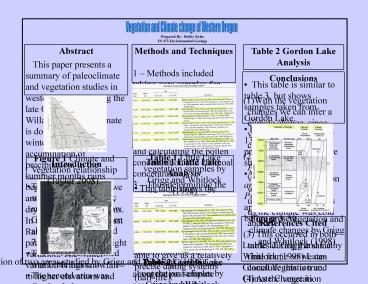Abstract - PowerPoint PPT Presentation
Title:
Abstract
Description:
Prepared By: Bobby Kelso ES 473 Environmental Geology Abstract This paper presents a summary of paleoclimate and vegetation studies in western Oregon during the late ... – PowerPoint PPT presentation
Number of Views:34
Avg rating:3.0/5.0
Title: Abstract
1
Vegetation and Climate change of Western Oregon
Prepared By Bobby Kelso ES 473 Environmental
Geology
Abstract This paper presents a summary of
paleoclimate and vegetation studies in western
Oregon during the late Quaternary. The
Willamette Valley climate is dominated by mild
winters with massive accumulation of
precipitation. In the summer months rains begin
to disappear and we are dominated by warm, dry
high pressure systems. In the Cascades and Coast
Range we see a similar pattern, but there is a
slight variation. The winter variation brings
snowfall to higher elevations and short lived,
intense thunderstorms in the summer. The
vegetation, in association with the law of
uniformitarianism, helps us unravel the past
climate. Different plant assemblages occurred in
the Willamette Valley and surrounding mountain
regions during the past 100,000 years. Since
plants are extremely sensitive to even minimal
climate changes, we can determine relatively
precise climate variations over time, based on
the sedimentary record.
Methods and Techniques 1 Methods included
taking core samples for Little Lake (15,700 and
10,200 B.P.) and Gordon lakes (15,500 and 8,500
B.P.). 2 Taking soil samples and calculating
the pollen concentration and charcoal
concentrations. 3 Thus determining the specific
plants found in that area during a specific time
period. 4- Then relating climate to vegetation
with the law of uniformitarianism. 5- Drawing
conclusions about the past climate associated
with the vegetation found.
- Table 2 Gordon Lake Analysis
- This table is similar to table 3, but shows
samples taken from Gordon Lake. - Between 7,760 and 13,040 years before present
similar trends are shown in this table. - A dominance of Picea and Pinus shifts to
Pseudotsuga as you approach 8,000 years before
present.
- Conclusions
- With the vegetation changes we can infer a
climate change, since vegetation is extremely
climate sensitive. - A period of Picea, Pinus, and subalpine
vegetation in association with the law of
uniformitarianism, tells us the climate was cold
and dry. - This occurred in both tables during the same
time frame so we can conclude this is true. - As the vegetation begins to shift to Pseudotsuga
about 10,000 years before present, by the same
principles can infer climate is warming and
receiving more precipitation. - Finally this tells us that the sea as climate
warms is rising because warmer global temperature
means less global ice. - Since the last glacial period was about 20,000
years before present, this makes sense.
Table 1 Little Lake vegetation samples by Grigg
and Whitlock (1998)
Figure 1 Climate and Vegetation relationship
(Taylor 2008).
- Table 1 Little Lake Analysis
- This table shows the time frame in which
specific vegetation was found throughout this
area. - Carbon 14 samples are able to give us a
relatively precise dating systems (half-life). - 13,170 before present the most dominant species
is Pinus and subalpine forest plants, then around
10,000 before present it begins to shift to
Pseudotsuga.
- Introduction
- Took samples of sediment from specific areas in
Oregon to show Climate change between about
13,000 years and 7,000 years. - The first area examined was Little Lake.
- The second area was Gordon Lake.
Figure 3 Vegetation and climate changes by Grigg
and Whitlock (1998)
References Cited Laurie D. Grigg and Cathy
Whitlock (1998) Late-Glacial Vegetation and
Climate Change in Western Oregon Quaternary
Research 49, Figure 2 p.288. Laurie D. Grigg and
Cathy Whitlock (1998) Late-Glacial Vegetation and
Climate Change in Western Oregon Quaternary
Research 49, Table 1 p.291. Laurie D. Grigg and
Cathy Whitlock (1998) Late-Glacial Vegetation and
Climate Change in Western Oregon Quaternary
Research 49, Table 2 p.293. Laurie D. Grigg and
Cathy Whitlock (1998) Late-Glacial Vegetation and
Climate Change in Western Oregon Quaternary
Research 49, Figure 3 p.294. Taylor, S.B., 2008
website Hydrology http//www.wou.edu/las/physci/ta
ylor/hydro/water_budget_files/frame.htm (2008)
Figure 2 Location of two areas studied by Grigg
and Whitlock (1998).
Table 2 Gordon Lake vegetation samples by Grigg
and Whitlock (1998).































